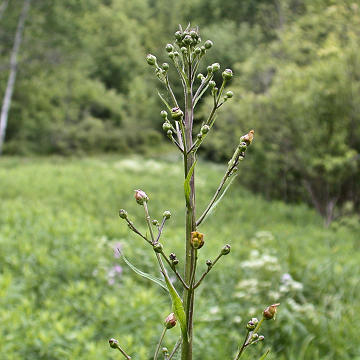

Scrophularia lanceolata - (image 1 of 6)
Taxonomy
Family: Scrophulariaceae
Habitat
Open woods, roadsides and fencerows. Especially frequent in sandy soils but also occurs in loam and clay soils.
Associates
Distribution
Quebec and Nova Scotia west to British Columbia, south to VA, MN, and NM.
Morphology
Herbaceous perennial to 2 m high. Leaves opposite, blades ovate to lance-ovate, acuminate, serrate or doubly-serrate, truncate to rounded at the base; petioles slender, not margined, usually less than a third as long as the blade. Stems glabrous below, the faces shallowly grooved or flat. Inflorescence large, terminal, paniculiform, loosely and irregularly branched, tending to be cylindric; flowers zygomorphic; corolla bilabiate, the upper lip directed forward, 7-11 mm, dull red-brown except the lower lobe which tends to be yellowish-green.
Notes
Flowers late May to July
Wetland indicator: Facultative +
Disturbance adapted.
References
Gleason, Henry A. and A. Cronquist. 1991. Manual of Vascular Plants of
Northeastern United States
and Adjacent Canada. Second Ed.
The New York Botanical Garden. Bronx, NY
Swink, F. and G. Wilhelm. 1994. Plants of the Chicago Region.
Indiana Academy of Science. The Morton Arboretum. Lisle, Illinois.
|
Michael Hough © 2005 |